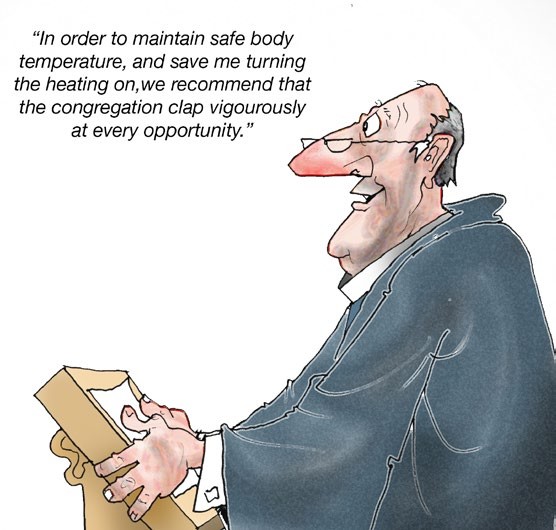LETTERS
Heat Savings
We had thought that there was no more scope to improve our carbon footprint from the buildings at Ayr St Columba, without major expense. But the volunteer project HeatHack proved us wrong. I want to tell you how your church could do the same.
HeatHack is a project that is hosted by “The Surefoot Effect” and the prestigious Royal Academy of Engineering provided all the funding for some years.
The financial cost of running the HeatHack process is low or zero. The starting point recommended by HeatHack is clear. It does not involve expense on insulation or draught proofing, and certainly not heat pumps or solar panels. These changes might come later on. HeatHack recommends heating areas in use to a target temperature for the period it is being used. Recordings of temperature and humidity are of central importance.
During February 2023 the gas consumption in our building was 2046 cubic meters. In February 2024 it was 1668 cubic meters. This is a saving of 378 cubic meters of gas or 19%. Jean Carletta (from HeatHack) did a weather check at the “Degree Days” website and showed that our system was working harder in 2024 which was also a day longer (a leap year), making the improvement nearer 25% when the exterior temperature is factored in.
Improvement in heating efficiency in old community buildings should be carried out in a set order, with expert support, using an established process. It would be encouraging to see HeatHack used more widely by the Church of Scotland. Initial contact should be made by email to info@heathack.org
Andrew Muirhead, Ayr

Cartoon: Bill McArthur
Constantine and Christianity
Lynne McNeil, in her editorial contribution to the April edition of Life and Work, referred to the fact that, at the Council of Nicaea in 325, the question of when Easter should fall was decided as the first Sunday following the first full moon after March 21 [the spring equinox]. Much progress was made at the Council but unanimity was not reached. As identified by Lynne, this date was not comprehensively accepted and the Eastern Orthodox churches celebrate Easter at a different and slightly later time.
That meeting of bishops and theologians had been convened by the Roman Emperor Constantine. He had been concerned to try and reduce the divisions within the Christian Church. At the Council in 325 provision was also made for the definition of the relationship between God the Father and God the Son, a definition which is still followed by most Christians today.
Constantine did much to improve the circumstances of Christians and to have the Christian religion more recognised, for example – the persecution of Christians was ended; Christians were promoted to high positions; the means was made available for Christian church buildings and projects; new copies of the Bible were commissioned and confiscated property was returned. It can be said that Emperor Constantine changed significantly the relationship between the Christian church and the Empire and that he promoted a course which led to Christianity becoming the official religion of the Empire with the consequences which ensued from that position.
Ian W Thomson, Lenzie
Presbytery Note
I have thoroughly enjoyed reading your “Our Presbyteries” features each month to date. Indeed, it is very interesting learning all about our brothers and sisters in other parts of Scotland and getting to grips with the new presbytery structures and the various challenges being presented going forward.
I was especially looking forward to the April edition which had been intimated as featuring our local Presbytery of Clyde, which has been an amalgamation of the former Presbytery of Dumbarton and Greenock and Paisley Presbytery.
Upon consultation of the aforementioned issue, I was somewhat surprised that it appeared to make no reference to the fact that Milngavie and Bearsden also form part of this presbytery, incorporating nine different Church of Scotland congregations across the two areas.
While I completely appreciate that you can’t mention every area in name, I personally felt that the article, albeit unintentionally, denoted that the presbytery comprises all of the places that are positioned along the River Clyde coast, with most of that area amply described and indeed many of the larger conurbations mentioned by name and the smaller peripheral hamlets also included in passing, but no mention of Milngavie or Bearsden which also form very much part of the presbytery but are geographically detached from the River Clyde itself.
John G McMenemy, Milngavie, East Dunbartonshire
Rose Appeal
In 2001 a beautiful rose named ‘Caring for You’ went on sale to raise funds for the church’s social care services.
It was created by the famous James Cocker and Sons, Aberdeen, but sadly it is no longer in stock.
I have one doughty survivor of the increasingly erratic weather, and would love to obtain more.
If anyone can spare any of their plants, or could take cuttings from them for me, I would be so grateful and would be happy to make a donation to Crossreach.
I can be contacted by email: jennifermary.speirs@googlemail.com
(Dr) Jennifer Speirs, Isle of Lewis
Life and Work welcomes letters from readers of not more than 350 words which can be sent by email to magazine@lifeandwork.org or by post to 121 George Street, Edinburgh EH2 4YN.
For verification purposes letters must be accompanied by the writer’s name, address and daytime telephone number. Anonymous letters will not be published.
In exceptional circumstances the Editor will consider publishing a letter withholding the details of the writer, provided verification can be made. The Editor reserves the right to edit letters for space and legal reasons.